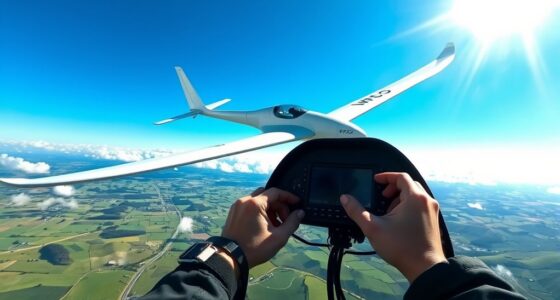In dense airspace, you should actively monitor your traffic awareness system and interpret alerts promptly, focusing on nearby aircraft’s positions and movements. Stay vigilant by cross-referencing system data with visual scans and anticipate potential conflicts early by recognizing patterns. Use Flarm alerts to plan quick, safe maneuvers, and guarantee proper maintenance and calibration for accurate info. Mastering these strategies enhances your safety; keep exploring for more tips to optimize your situational awareness.
Key Takeaways
- Regularly update and calibrate Flarm systems to ensure accurate, real-time traffic data in dense airspace.
- Maintain vigilant visual scanning alongside traffic awareness displays to enhance situational understanding.
- Analyze movement patterns and alerts proactively to anticipate potential conflicts early.
- Prioritize monitoring targets at various altitudes and directions to avoid blind spots.
- Use system alerts to inform timely avoidance maneuvers, reducing reactive responses in crowded airspace.

Effective use of Flarm and traffic awareness systems can substantially enhance your safety during flight. When flying through dense airspace, these tools become essential for maintaining collision avoidance and situational awareness. They give you real-time information about surrounding aircraft, helping you make quick, informed decisions to prevent accidents. By integrating these systems into your flying routine, you can better anticipate potential conflicts and respond proactively, rather than reactively.
Your primary goal is to use Flarm and traffic awareness systems to create a clear picture of your environment. As you navigate busy skies, keep a close eye on the display, paying attention to nearby targets, their relative positions, and movement. These systems work by detecting transponder signals from other aircraft and alerting you to their presence. It’s vital to interpret these alerts correctly — understanding the direction and speed of nearby traffic helps you assess risks and plan your actions accordingly. Maintaining heightened situational awareness means you’re less likely to be caught off guard, especially in unpredictable situations where multiple aircraft converge.
Use traffic systems to monitor targets, interpret signals accurately, and stay alert for a safer flight environment.
In dense airspace, constant vigilance is key. Use your traffic awareness system to monitor various altitudes and directions, not just the aircraft immediately ahead. Recognize patterns and anticipate where conflicts might develop. For example, if a target aircraft appears to be on a converging course, you can adjust your altitude or heading early enough to avoid a collision. Remember that these systems are tools to assist, not replace your judgment. Always cross-reference your visual scan with the data on your traffic display, especially in complex scenarios. This dual approach increases your collision avoidance capabilities and reinforces your overall situational awareness.
Additionally, regularly update your system’s database and ensure your equipment is functioning properly before each flight. An outdated or malfunctioning system can give false readings or miss critical targets, undermining your safety. Properly calibrated and current data guarantee your traffic awareness system provides accurate, actionable information. Regular system checks are essential for ensuring your traffic awareness tools operate effectively and reliably during your flight.
Frequently Asked Questions
How Do Flarm Systems Integrate With Other Aviation Navigation Tools?
You connect Flarm systems with other aviation navigation tools through interoperability protocols and system compatibility features. These guarantee seamless data sharing and integration, allowing your devices to communicate effectively. By adhering to standard protocols, your Flarm can work alongside GPS, ADS-B, and other traffic awareness systems, enhancing situational awareness. This integration helps you maintain safe separation, especially in dense airspace, and improves overall navigation efficiency.
What Are the Limitations of Flarm in Dense Airspace?
In dense airspace, Flarm has limitations like sensor issues and signal interference, which can reduce its effectiveness. You might experience missed alerts or false signals due to obstacles or electronic noise. To stay safe, you should not rely solely on Flarm. Instead, combine it with visual scanning and other traffic awareness tools. Being aware of these sensor limitations helps you make better decisions and avoid potential collisions.
How Does Traffic Awareness Technology Handle Multiple Aircraft at Once?
Traffic awareness technology handles multiple aircraft at once through multi aircraft detection, which continuously scans and updates the positions of nearby aircraft. It uses algorithms to filter and prioritize alerts, helping you manage congestion effectively. The system provides real-time data, allowing you to maintain safe separation in dense airspace, reduce collision risks, and make informed decisions quickly. This proactive approach enhances safety by managing multiple aircraft efficiently.
What Training Is Recommended for Effective Use of Traffic Awareness Systems?
Like a skilled pilot steering through clouds, you should undergo thorough training to master traffic awareness systems. Focus on visualization techniques to interpret alerts quickly and accurately. Regularly drill emergency procedures to respond swiftly in critical moments. This training builds your confidence and sharpens your situational awareness, enabling you to effectively use the technology in dense airspace and maintain safety for everyone onboard.
Are There Cost-Effective Options for Small or Private Aircraft Operators?
Yes, you can find affordable solutions for small or private aircraft operators. Budget-friendly options include used or refurbished Flarm units, which substantially reduce costs. Some manufacturers offer entry-level traffic awareness systems tailored for smaller aircraft, providing essential functionality without the high price tag. Additionally, exploring bundled packages or seeking off-season deals can help you access reliable, cost-effective traffic awareness technology, ensuring safety without straining your budget.
Conclusion
By integrating Flarm and traffic awareness systems, you navigate dense airspace like a skilled pilot steering through a crowded sky. These tools act as your vigilant co-pilots, constantly alert and prepared to warn you of potential conflicts. Embrace these strategies, and you’ll fly with confidence and safety, much like a bird weaving gracefully through a flock. Remember, in busy skies, staying proactive and aware keeps you out of trouble and ensures a smooth journey ahead.
With a heart that soars as high as the skies, Aria, affectionately known as “Skylark,” is the driving force behind Soaring Skyways. Her journey into the gliding world began as a young dreamer gazing up at the soaring birds, yearning to experience the weightlessness and freedom they embodied. With years of experience both in the cockpit and behind the scenes, Aria’s commitment to the gliding community is unwavering.









